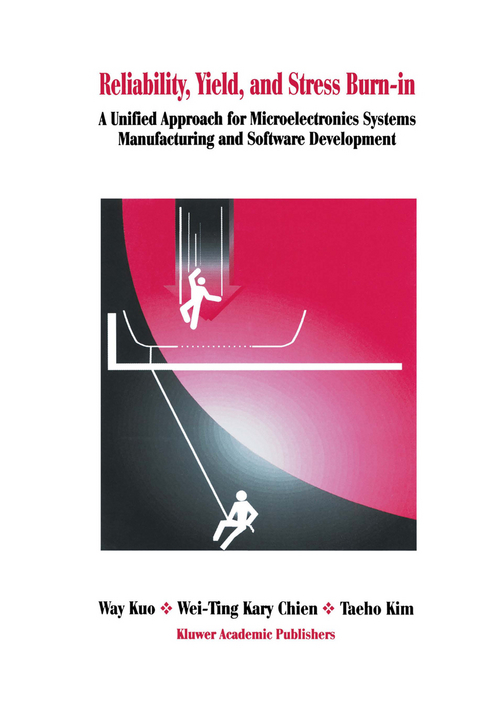
Reliability, Yield, and Stress Burn-In
Springer (Verlag)
978-0-7923-8107-5 (ISBN)
The international market is very competitive for high-tech manufacturers to day. Achieving competitive quality and reliability for products requires leader ship from the top, good management practices, effective and efficient operation and maintenance systems, and use of appropriate up-to-date engineering de sign tools and methods. Furthermore, manufacturing yield and reliability are interrelated. Manufacturing yield depends on the number of defects found dur ing both the manufacturing process and the warranty period, which in turn determines the reliability. the production of microelectronics has evolved into Since the early 1970's, one of the world's largest manufacturing industries. As a result, an important agenda is the study of reliability issues in fabricating microelectronic products and consequently the systems that employ these products, particularly, the new generation of microelectronics. Such an agenda should include: • the economic impact of employing the microelectronics fabricated by in dustry, • a study of the relationship between reliability and yield, • the progression toward miniaturization and higher reliability, and • the correctness and complexity of new system designs, which include a very significant portion of software.
1 Overview of Design, Manufacture, and Reliability.- 1.1 Production and Manufacturing Issues.- 1.2 Taguchi Method in Quality Engineering.- 1.3 Manufacturing Design and Reliability.- 1.4 Reliability Standards.- 1.5 Conclusions.- 2 Integrating Reliability into Microelectronics Manufacturing.- 2.1 Microelectronics Manufacturing.- 2.2 New Techniques for Reliability Improvement.- 2.3 Manufacturing Yield and Reliability.- 2.4 Conclusions.- 3 Basic Reliability Concept.- 3.1 Elements of Reliability.- 3.2 Some Useful Life Distributions.- 3.3 Strength and Stress Analysis.- 3.4 Multicomponents Systems.- 3.5 Conclusions.- 4 Yield and Modeling Yield.- 4.1 Definitions and Concept.- 4.2 Yield Models.- 4.3 Yield Prediction.- 4.4 Yield Estimation.- 4.5 Fault Coverage and Occurrence.- 4.6 Yield-reliability Relation Model.- 4.7 Cost Model.- 4.8 Conclusions.- 5 Reliability Stress Tests.- 5.1 Accelerated Life Tests.- 5.2 Environmental Stress Screening (ESS).- 5.3 Failures and Reliability Prediction.- 5.4 Conclusions.- 6 Burn-in Performance, Cost, and Statistical Analysis.- 6.1 Design of Burn-in.- 6.2 Performance and Cost Modeling.- 6.3 Burn-in Optimization.- 6.4 Statistical Approaches for Burn-in Analysis.- 6.5 Conclusions.- 7 Nonparametric Reliability Analysis.- 7.1 The Proportional Hazard Rate Model.- 7.2 The Life Table Estimator (LTE).- 7.3 The Kaplan-Meier Product Limits Estimator.- 7.4 Goodness-of-fit (GOF) Tests.- 7.5 Smoothing Techniques.- 7.6 Conclusions.- 8 Parametric Approaches To Decide Optimal System Burn-in Time.- 8.1 A Time-independent Model.- 8.2 A Time-dependent Model.- 8.3 Conclusions.- 9 Nonparametric Approach and Its Applications to Burn-in.- 9.1 Introduction.- 9.2 Methods.- 9.3 Applications.- 9.4 Conclusions.- 10 Nonparametric Bayesian Approach for Optimal Burn-in.- 10.1The Dirichlet Distribution.- 10.2 The Model Formulation.- 10.3 Other Considerations.- 10.4 Conclusions.- 11 The Dirichlet Process for Reliability Analysis.- 11.1 Method.- 11.2 Variance Reduction in the Dirichlet Process.- 11.3 Determining Optimal Burn-in Time Using the Dirichlet Process.- 11.4 Conclusions.- 12 Software Reliability and Infant Mortality Period of the Bathtub Curve.- 12.1 Basic Concept and Definitions.- 12.2 Stochastic Software Reliability Models.- 12.3 The Non-stochastic Software Reliability Models.- 12.4 A Proposed Procedure of Testing Data.- 12.5 Software Reliability Management.- 12.6 Conclusions.- Epilogue: Cost-effective Design for Stress Burn-in.- References.- Appendices.- A Notation and Nomenclature.- B Failure Modes for Parts.- C Common Probability Distributions.- C.1 Discrete Distributions.- C.2 Continuous Distributions.- D Simulation for U-shaped Hazard Rate Curves.- D.1 Generating U-shaped Hazard Rate Curves.- D.2 Simulation.- E Sample Programs.- E.1 A Sample GINO Program.- E.2 A Sample GAMS program.
| Zusatzinfo | XXVI, 394 p. |
|---|---|
| Verlagsort | Dordrecht |
| Sprache | englisch |
| Maße | 155 x 235 mm |
| Themenwelt | Technik ► Elektrotechnik / Energietechnik |
| Technik ► Maschinenbau | |
| ISBN-10 | 0-7923-8107-6 / 0792381076 |
| ISBN-13 | 978-0-7923-8107-5 / 9780792381075 |
| Zustand | Neuware |
| Haben Sie eine Frage zum Produkt? |
aus dem Bereich


